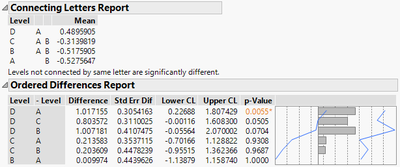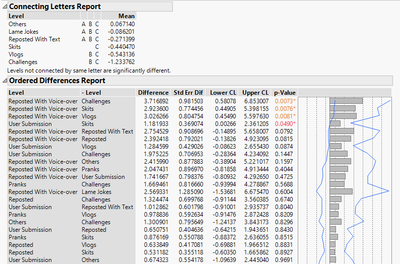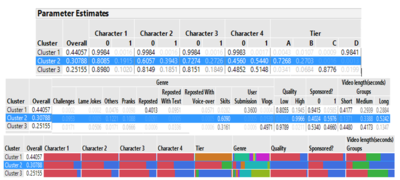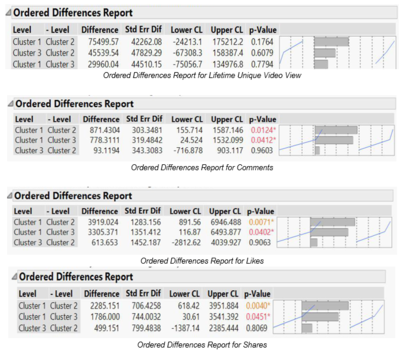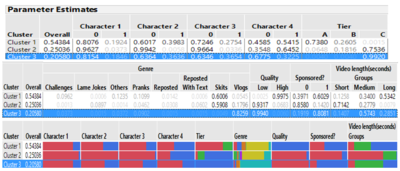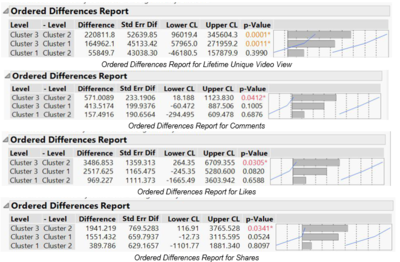AY1617 T5 Team AP Findings Finals
ANOVA & TUKEY-KRAMER ANALYSIS
We used the SAS JMP Pro function - All Pairs, Tukey HSD, to execute the Tukey-kramer comparison tests. Subsequently, the connecting letters report and ordered differences report were produced to assist in comparability of factor level means. The connecting letters report indicate similar means with the same letters while those means not sharing a letter are significantly different from one another. While for the ordered differences report shows the ranked differences with a confidence interval band over the plot together with the significance level (p-value), with anything less than significance level of 0.05 would be indicative of significance difference in factor means.
Character
There was significant difference in video performance in the absence of Character4, in other words, videos are performing better without Character4 in it. This could be seen from the connecting letters report with both factor level means showing different letters, 0 representing absence of Character4 while 1 represents the presence of Character4. This is further supported by the ordered difference report where the p-value is less than 0.05, indicative of the significant positive difference brought about by the absence of Character4.
Tier
There was significant difference in video performance for ( Tier D – Tier A ), in other words, videos under tier D are performing better than tier A. This could be seen from the connecting letters report with both factor level means showing different letters with Tier D showing A and Tier A showing B. This is further supported by the ordered difference report where the p-value is less than 0.05 at 0.0055, indicative of the significant positive difference brought about by tier D as compared to tier A.
Genre
There was significant positive difference in video performance for reposted with voice-over over challenges, skits and vlogs. Additionally, user submissions are doing significantly better than skits. This could be seen from the ordered difference report where the p-value are less than 0.05, providing a at least a 95% confidence that the aforementioned differences are indeed significant.
The remaining factors such as quality, sponsorship, Character1, Character2, Character3, does not show any form of statistical significance based on Tukey-Kramer comparison test.
In conclusion, Tukey-Kramer is considered the best available method for all pairwise comparisons when confidence intervals are needed or sample sizes are not equal. Additionally, for small number of groups, the loss of power will be slight making it a good alternative as most software comes with Tukey-Kramer comparison test.
LATENT CLASS ANALYSIS
Using the latent class analysis, we were able to identify 3 separate clusters. Based on the probabilities, we were able to identify which variables contribute more to the distinctiveness of each cluster. The first cluster is of Tier D, user submission and reposted, low quality, unsponsored, short videos with no character presence. The second cluster is Tier A skits which are of high quality and longer length. The last cluster consists of Tier C vlogs which are of low quality with short to medium video lengths.
To identify which clusters are performing better than the others, we carried out the ANOVA and Tukey-Kramer HSD tests with our 4 KPIs as the response variables. From the results above, we can see that, with the exception of the Lifetime Unique Video Views, Cluster 1 dominates all of the KPIs. This shows that videos with characteristics of cluster 1 is most likely going to perform better in terms of video performances.
However, since cluster 1 is predominantly Tier D videos (non-original videos), this insight will only assist our client in understanding how to increase Facebook engagements and not sponsorship revenue. Thus, we partitioned out the original videos and redid the latent class analysis solely on these data to identify clusters characteristics that were outperforming the rest. This allowed us to identify insights that were relevant in allowing our client to charge a higher sponsorship fees to increase revenue based on hard facts. With more insights obtained from the original videos (Tier A,B,C), our client would be able to increase their self-produced videos’ Facebook engagement and make it more attractive in terms of advertising reach for their sponsors.
For all original videos (Tier A, B, C), we generated 3 different clusters. The first cluster contains videos from Tier A, which are mainly skits of high quality, and which video lengths were medium to long. The second cluster consists of unsponsored Tier C skits which were of low quality and has a short video length. The last cluster encompasses being sponsored, Tier C vlogs with low quality videos.
To identify the better forming clusters, we repeated the ANOVA and Tukey-Kramer HSD tests. From Figure 20, we can see a significant difference in the Lifetime Unique Video Views between Cluster 3 and Cluster 2, as well as between Cluster 3 and Cluster 1. As for the rest of the 3 KPIs, Cluster 3 is significantly outperforming Cluster 2. Subsequently, Cluster 3’s characteristics could be used to generate higher video performances for videos being produced by our client.









